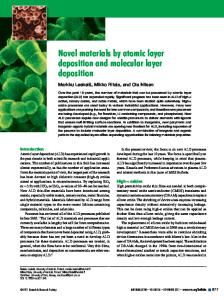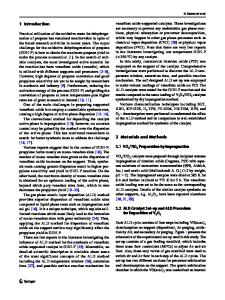Surface Preparation Techniques for the Atomic Layer Deposition of Hafnium Oxide
- PDF / 787,915 Bytes
- 6 Pages / 612 x 792 pts (letter) Page_size
- 35 Downloads / 369 Views
0917-E10-05
Surface Preparation Techniques for the Atomic Layer Deposition of Hafnium Oxide Laura Nyns1,2, Lindsey Hall3, Thierry Conard1, Annelies Delabie1, Wim Deweerd1, Marc Heyns1, Sven Van Elshocht1, Nausikaa Van Hoornick1, Chris Vinckier2, and Stefan De Gendt1,2 1 IMEC, Kapeldreef 75, Heverlee, 3001, Belgium 2 Department of Chemistry, KULeuven, Celestijnenlaan 200F, Heverlee, 3001, Belgium 3 Silicon Technology Development, Texas Instruments, P.O. Box 650311, Dallas, Texas, 75265
ABSTRACT Since Atomic Layer Deposition (ALD) is a surface sensitive growth technique, optimization of the silicon surface prior to high-ĸ deposition is often required. The impact of various wet chemical oxidations and wetting a thermal oxide with HF on the nucleation and growth of thin HfO2 layers with the ALD HfCl4/H2O process has therefore been evaluated. Our results demonstrate that the HfO2 deposition is more dependent on the thickness of the SiO2 layer than on the chemistry used to grow this oxide. This dependence is first characterized by a linear increase, induced by an increasing OH surface concentration as the oxide measures thicker. Saturation of the HfO2 deposition occurs once an ellipsometric oxide thickness of approximately 0.8 nm is reached. Achieving a maximum in OH coverage, or steric hindrance of the adsorbed precursor molecules is causing this limitation. Furthermore, electrical characterization revealed that both interfacial oxides show identical leakage scaling behaviour down to an EOT of 0.8 nm.
INTRODUCTION Atomic Layer Deposition (ALD) has been considered as one of the proper techniques for depositing thin high-ĸ layers, since it offers many advantages such as excellent conformality, good uniformity and sub-monolayer thickness control of the deposited films. These characteristics are ensured by the self-limiting growth mechanism where ALD is based on. For HfO2, scaling of the Equivalent Oxide Thickness (EOT) to the sub-1 nm range has been reported for both HfCl4/H2O [1,2] and tetrakis(ethylmethylamino)hafnium (TEMAH)/O3 [3] ALD. While the latter has been shown to be independent on silicon surface preparation [4], the exposure to O3 could increase the interfacial oxide thickness during HfO2 growth. By using a less strong oxidant as in the HfCl4/H2O process, re-oxidation of the silicon substrate during ALD will be limited. However, controlled ALD growth with this precursor combination requires the presence of reactive OH sites on the silicon substrate prior to HfO2 deposition, since a low OH surface density may inhibit the deposition during the first reaction cycles. Growth inhibition has been associated with island growth of the metal oxide, causing multiple weak spots in the film and degrading its quality [5,6,7]. Optimization of the starting surface is therefore mandatory. However, care should be taken to control the thickness of the grown interfacial oxide, as it will contribute to the EOT of the dielectric stack. Ideally, the silicon surface would be completely covered by reactive hydroxyl groups without an
Data Loading...










